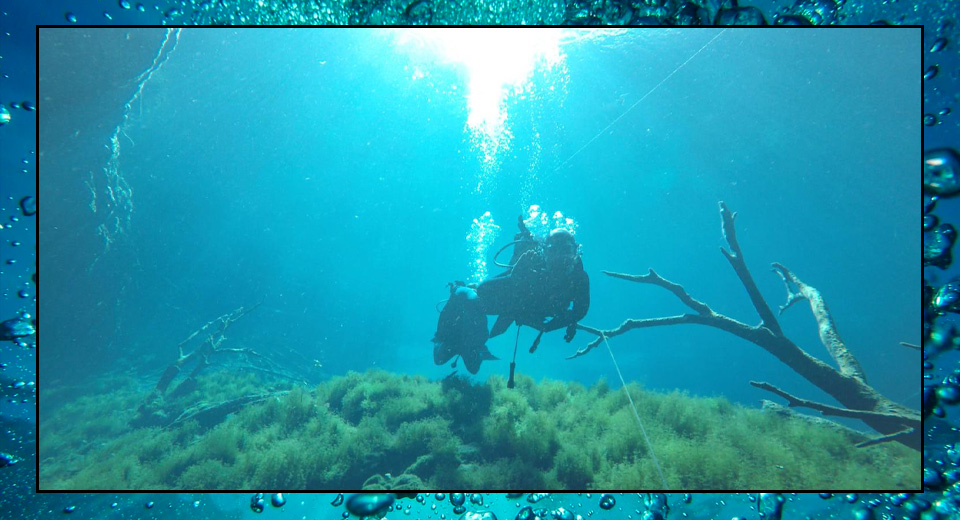Ocean Plants by Dr Helen Czerski
Sea Shambles Advent Calendar Day 18December 18th
It’s a plant, Jim, but not as we know it.

This photo was contributed by my neighbour Tom, who is currently full of enthusiasm for SCUBA diving (having completed his dive qualification two weeks ago). I’m cheating slightly here, because this photo was taken in a cenote rather than the ocean itself. A cenote is a sinkhole, a sunken pit often associated with the Yucatan peninsula in Mexico. The best thing about cenotes is that the rock that they plunge through is porous, and so seawater can sneak through the rock from the side to fill the bottom of the pit. It meets fresh rainwater that’s been funnelled into the top, and consequently many cenotes have two water layers sitting on top of each other: salty seawater below and fresh rainwater on top.
The reason I picked this picture is because of what’s carpeting the floor: plants. Tom’s general opinion was that caves were really exciting, but places where there were “just plants” were best used as thoroughfares, not a final destination. I disagree. But the reason why is tied up in what a “plant” in the ocean actually is.
Photosynthesis is one of the most essential processes for all life on Earth: the harvesting of sunlight to build life’s construction materials (sugars, proteins, lipid and more) from raw materials, and creating oxygen as a by-product. About half of all the oxygen in Earth’s atmosphere comes from photosynthesis that happens in the ocean. But most of that half has nothing to do with plants. The heavy lifting is done by vast numbers of tiny phytoplankton that drift around the ocean surface, and these are algae, not plants. Land plants evolved from green algae, many hundreds of millions of years ago, and they’ve been separate ever since. Seaweeds (like the frond-like slightly slimy ribbons that wash up on beaches) are algae. A land plant has internal plumbing to help move water and sugars around, but seaweed has none of that. A land plant has roots and seeds and burrows down into soil to extract nutrients, but seaweed just clings on to the outside of a rock. Many land plants have flowers, and seaweed certainly doesn’t have those. They’re (often) both green or brown on the outside, but pretty much everything on the inside couldn’t be more different.
The Cosmic Shambles Network relies on your support on pledges via Patreon so we can continue to provide great, new, exciting content without the need for third party ads or paywalls.
For as little as $1 a month you can support what we do and get some great rewards for doing so as well. Click the Patreon logo to pledge or find out more.
But that’s what makes the plants in this picture so interesting. These are species that evolved on land, as land plants, and then moved back into the ocean. I think that this part of the cenote had fresh water, so these are freshwater plants, but the ocean itself hosts a very important group of renegade plants: the seagrasses.
Seagrasses are fascinating: they’re descendants of flowering plants, so they have flowers, seeds, roots and leaves, just like flowering plants on land. They’ve got a fairly hefty series of modifications to allow them to live in seawater, but they have basically the same structure as a daffodil. This makes the seagrasses the plant equivalent of dolphins and whales, which evolved from land mammals that moved back into the sea.
Seagrasses form huge underwater meadows, which provide shelter and food for all sorts of animal species. These meadows are extraordinarily productive ecosystems, which also improve water quality and stabilise the seafloor (just as trees on land help prevent erosion). They’re also very efficient at extracting and storing carbon, meaning that they are vital allies in the fight against ever-increasing levels of atmospheric carbon.
So I think that although algae is pretty awesome, actual real plants in the ocean could do with getting a bit more press. It’s amazing enough that they’re successful refugees from the land (how can you beat underwater flowers?), but they’re also very important for the health of the coastal ocean. I reckon that Tom probably still won’t find them as exciting as caves, but maybe he’ll at least stop to look at them next time he swims over some.
See what lies behind all the windows of the Sea Shambles Advent here.
 Sea Shambles is a one night only live extravaganza celebrating the oceans. Hosted by Robin Ince and Helen Czerski with Steve Backshall, British Sea Power, Josie Long, Lemn Sissay and more it’s a night of science, comedy, music, lasers and more in which we’ll be turning the Royal Albert Hall into an underwater playground the likes of which you’ve never seen! May 17 2020. Tickets start at just £10! Book here.
Sea Shambles is a one night only live extravaganza celebrating the oceans. Hosted by Robin Ince and Helen Czerski with Steve Backshall, British Sea Power, Josie Long, Lemn Sissay and more it’s a night of science, comedy, music, lasers and more in which we’ll be turning the Royal Albert Hall into an underwater playground the likes of which you’ve never seen! May 17 2020. Tickets start at just £10! Book here.
 Dr Helen Czerski is a physicist, first and foremost, but she’s acquired a few other labels along the way: oceanographer, presenter, author and bubble enthusiast. A regular on The Cosmic Shambles Network, she has also presented a number of acclaimed documentaries for the BBC and Fully Charged. Recently she was awarded the prestigious William Thomson, Lord Kelvin Medal and Prize from the Institute of Physics.
Dr Helen Czerski is a physicist, first and foremost, but she’s acquired a few other labels along the way: oceanographer, presenter, author and bubble enthusiast. A regular on The Cosmic Shambles Network, she has also presented a number of acclaimed documentaries for the BBC and Fully Charged. Recently she was awarded the prestigious William Thomson, Lord Kelvin Medal and Prize from the Institute of Physics.
If you would like to reuse this content please contact us for details
Subscribe to The Cosmic Shambles Network Mailing list here.
The Cosmic Shambles Network relies on your support on pledges via Patreon so we can continue to provide great, new, exciting content without the need for third party ads or paywalls.
For as little as $1 a month you can support what we do and get some great rewards for doing so as well. Click the Patreon logo to pledge or find out more.

